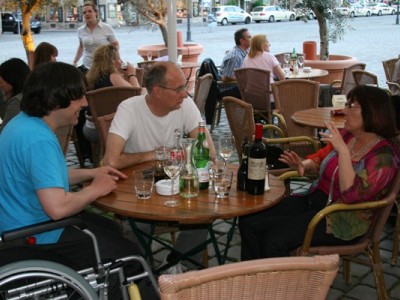 We finished the day off with a stroll into town and a meal on the terrace of the Provenza restaurant in the Hauptmarkt.
We finished the day off with a stroll into town and a meal on the terrace of the Provenza restaurant in the Hauptmarkt.
In 1986, I went to the Bayreuth Festival.
I flew from Manchester Airport to Frankfurt. From there I took a train to Nuremberg and thence changed to a small regional train for the final leg.
In 1997, I travelled to Köln from London. I went from London to Brussels by Eurostar. From Brussels, I travelled by an Intercity train through Aachen to Köln.
Our journey from Brussels to Nuremberg via Frankfurt filled in the gap down the Rhine valley.
One moment I remember well from that first holiday was looking at the train announcements board on Nuremberg station. The station is a middling sized regional railway station - Crewe might be of a similar status in England. From Crewe, trains go to Glasgow, London, Hollyhead, Liverpool, Manchester and Birmingham, Norwich, etc. From Nuremberg, trains go to Vienna, Rome, Athens, Paris, Copenhagen, Madrid, etc. Before the advent of Eurostar, it was therefore much easier to believe that you were a part of continental Europe when you were in Nuremberg. It felt truly romantic.
Actually the railway journey was not without incident. Ross's mum had taken account of the fact that we had to change trains in Frankfurt and had built in a substantial amount of time in order to facilitate the change over. Lucky she did. Our first ICE (Inter-City Express) train broke down half an hour out of Frankfurt.
Firstly, they tried to fix it. Then the told us to change trains for another service. However, this train only went as far as the airport and then we would have to change to another train form the remainder of the journey. The first train was jam packed. Some kind soul gave Ross a seat; the rest of us stood. Not knowing the protocols, there was quite a bit of faffing at the airport station. Lots of farcical running up and down stairs and going to wrong platforms. However, we got a train to Frankfurt Hauptbahnhof eventually and were still in time for our train to Nuremberg.
I'm not all that impressed by the ICE trains. Breakdowns apart, our Virgin Pendolinos are at least as comfortable in First Class and the toilets and freebies are much better. ICE do have more spacious legroom however. On neither service do the radio and video services work properly. Luckily, we have our own media library on the laptop.
Anyhow, we arrived in good time at our new hotel, Le Méridien Grand Hotel just opposite the main railway station. According to the brochure in our room, we are being treated to a welcoming Art Deco style - I don't see that I'm afraid. I do like the big bath, however. I suspect that total immersion is going to be a real treat on this holiday.
Certain things now seem to be standard in this class of hotel. Like
However
Still, I'm sure we'll manage for one day.
 We finished the day off with a stroll into town and a meal on the terrace of the Provenza restaurant in the Hauptmarkt.
We finished the day off with a stroll into town and a meal on the terrace of the Provenza restaurant in the Hauptmarkt.
We watched the world go by and enjoyed the sight of the setting sun on the delightful Frauenkirche to our right and the delicate tracery of the Schönem Brunnen (Beautiful Fountain) on the left.
Then it was time for bed.
 We had another fabulous breakfast. I could quite get into this idea of a leisurely four course breakfast. And then the four of us set out for a stroll through old Nuremberg. Ross's dad took this picture of Ross and I on a bridge over the River Pegnitz
We had another fabulous breakfast. I could quite get into this idea of a leisurely four course breakfast. And then the four of us set out for a stroll through old Nuremberg. Ross's dad took this picture of Ross and I on a bridge over the River Pegnitz
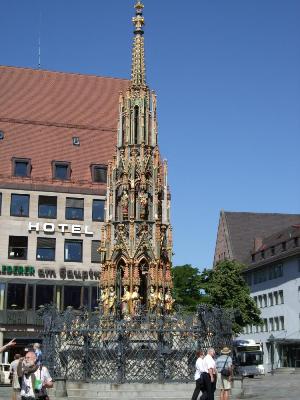 We pretty much followed the same route as we had taken the night before passed the Lorenzkirche. We popped in but it was full of people setting up for a Bach organ recital due to take place in the evening as part of Nuremberg's International Organ Week. So, on to the Hauptmarkt which was full of Saturday market stalls selling a wonderful array of beautifully displayed vegetables.
We pretty much followed the same route as we had taken the night before passed the Lorenzkirche. We popped in but it was full of people setting up for a Bach organ recital due to take place in the evening as part of Nuremberg's International Organ Week. So, on to the Hauptmarkt which was full of Saturday market stalls selling a wonderful array of beautifully displayed vegetables.
We took a while to admire the Schönem Brunnen (Beautiful Fountain) in daylight. I'm particularly pleased with the photo below which shows the figures on the fountain in all their colourful glory.

We schlepped up a very steep hill to get to the Kaiserburg.

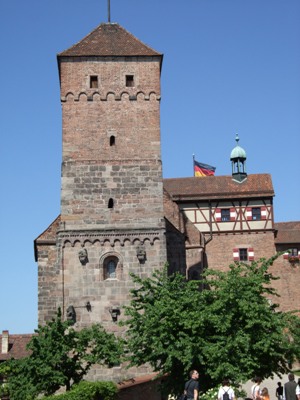

Unlike many British counterpoints entry onto the site was absolutely free. Ross did not join us in the final ascent because it was simply too precipitous.

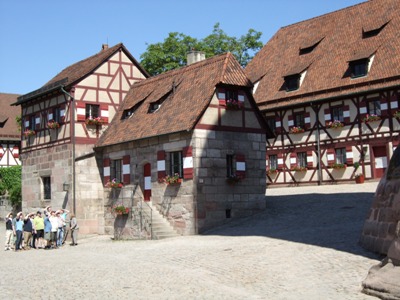
 Coming down the other side, we arrived in a small square in front of the Tiergärtnertor (Gamekeeper's Gate) which I recognised from my previous visit 25 years ago. One big addition was this statue of hare. It was placed here in honour of Albrecht Dürer, a son of Nuremberg whose memorial house/museum was just round the corner. I was gasping for a beer so we sat in a nearby biergarten.
Coming down the other side, we arrived in a small square in front of the Tiergärtnertor (Gamekeeper's Gate) which I recognised from my previous visit 25 years ago. One big addition was this statue of hare. It was placed here in honour of Albrecht Dürer, a son of Nuremberg whose memorial house/museum was just round the corner. I was gasping for a beer so we sat in a nearby biergarten.
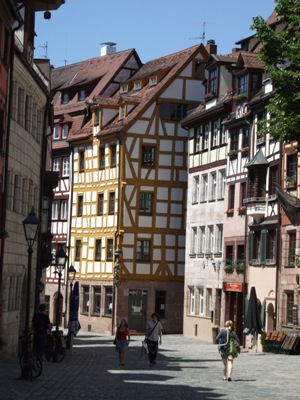 And here, I want to say something about my reaction to Nuremberg. The town was almost obliterated in the bombing at the end of the Second World War. 90% of buildings in the central area near the railway sidings were levelled. What you see above and below is all a careful restoration.
And here, I want to say something about my reaction to Nuremberg. The town was almost obliterated in the bombing at the end of the Second World War. 90% of buildings in the central area near the railway sidings were levelled. What you see above and below is all a careful restoration.
Sensibly, the city planners of the 1950s took the advantage of an enforced brown field site and dug two short U-Bahn lines through the southern city centre (there was a similar plan or work adopted in Köln, though on a more extensive scale). The system is limited but I'll bet it really helps with the overall rapid transport system. The scheme couldn't have been managed quite so easily using the trench system employed if the planners had been dealing with original sixteenth century buildings on top.
The end result is all very clean and very meticulously achieved. In fact, the city centre is pristine - so pristine as to appear sanitised. I can understand why some Germans feel as though it is like Disneyland - a theme park for an idealised Germanic past, a German past from which came the ideas for a beastly regime.


And so, just as I was arriving at my heritage-industry-in-aspic view of the city, we entered the church of St Sebald. From the outside, this had certainly looked very different from the Brabant Gothic churches of Brussels, there were a couple of towers at the western end then a narrow nave which led into a large chapel with a high gabled roof at the eastern end of the building. I think that the style of architecture is called Romanesque but I shall have to research that detail. Anyhow, the overall effect of the shape was like a great garden snail moving through the city. And there's no disrespect meant in that comparison even though it feels like something which Terry Gilliam might have made a great cartoon out of.
The first treat for Rossi and I was the number of medieval wall paintings. There were patterns up the internal columns, coloured panels framing each niched statue and a gigantic mural of St Christopher bearing the Christ over the stream. Though the colours were faded, there remained the ghost of how intensely bright the originals would have been.


The murals continued down the nave and into the chapel.
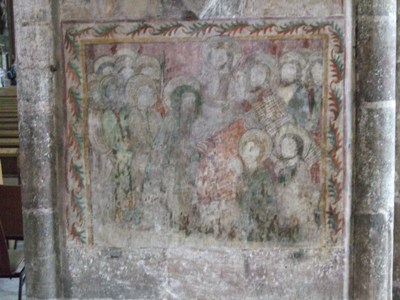
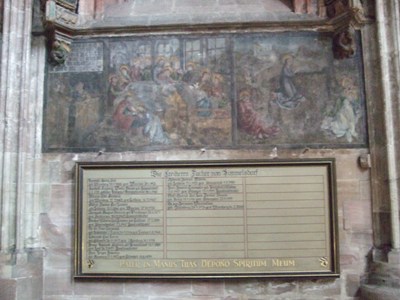
And then we got to the chapel and my mouth gaped open. It was like entering a forest glade with the light dappling through the stained glass windows. It was all staggeringly beautiful and an incredible spiritual experience, quite humbling when you remembered the ashes from which this phoenix must have arisen.
![]()
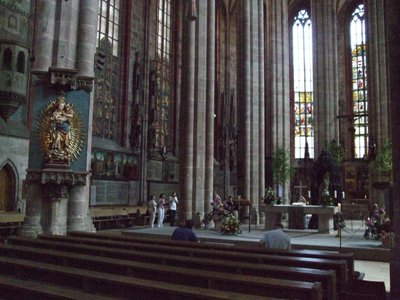
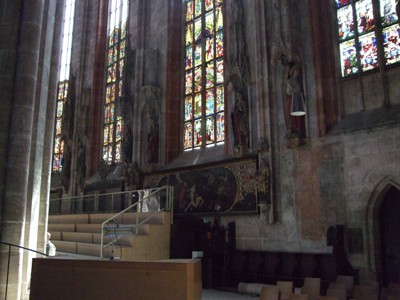
Within the church there were a number of posters which detailed the devastation caused during those bombing raids of 1944/45. As you can see from the photographs, the church was pretty much burnt out.


That means, of course, that, although the basic structure was original, the roof and the fixtures were a very good and a very loving restoration. And what Ross and I wondered was this - how much of the medieval art on the walls of the church which we had delighted in would have been visible today if the building had not been burnt and then restored?
Lunch was a quick coffee and a piece of cake and then we all went our separate ways.
I wandered down the main shopping drag towards the White Tower (all the towers of the city walls and the Kaiserburg are given individual names which feels like something out of Tolkein). I happened upon a political demonstration. Mostly the folk were of Turkish extraction. They were protesting against the way that soldiers from the state of Israel had boarded a ship carrying humanitarian supplies to the Gaza strip and had killed a number of the aid workers.
I wondered if there were any Germans who felt uneasy about protests against the Jewish state of Israel taking place in southern Germany. I wondered if many Germans felt that they couldn't join the protest for fear of their motives being misunderstood. I wondered if there was any sense of resentment that the protests were being led by foreign workers - I seem to remember that Germans have long had an uneasy relationship with the large community of gastarbeiten foreign workers (mostly Turkish) on whom their economy relied.
And from there I walked on to the Germanisches Nationalmuseum, the national gallery and museum of German arts. And I was entranced.
We could not, in the UK, assemble a collection of medieval artworks to rival this because it all went into the fires. From the period of the dissolution of the monasteries to the end of the Civil War, there was over 100 years of artistic purging. I well remember the comment from a Chinese visitor looking at Ely cathedral which noted that we in the UK had experienced a cultural revolution akin to the Maoist cleansing.
What did I see?
Rooms full of 13th-14th century tapestries of superlative design, richly patterned and full of bold colours. Sacred and secular statuary in stone, wood, metal, ceramics and pottery. Paintings of every type, sacred subjects oft repeated, portraiture, still lives and landscape scenes. And again and again bold, bold colour. Whoever thought that the early medieval period was the Dark Ages.
 I loved the simplicity of a 12th century crucifix in simple, unadorned wood. I was astounded by a painting from 1445 of The Annunciation of the Virgin by Konrad Witz which, with its crazy perspectives, could have been painted by either de Chirico or Magritte and which, with its energetic folds of fabric, could also have been painted by El Greco.
I loved the simplicity of a 12th century crucifix in simple, unadorned wood. I was astounded by a painting from 1445 of The Annunciation of the Virgin by Konrad Witz which, with its crazy perspectives, could have been painted by either de Chirico or Magritte and which, with its energetic folds of fabric, could also have been painted by El Greco.
I fell in love with the portraits by Dürer. I was knocked out by a stunning full length nude study of Venus and Cupid by Lucas Cranach. I laughed out loud at the exuberance of a depiction of the martyrdom of St Ursula rendered as a circular, three-dimensional pottery plaque. It was a superb experience.
![]()
Oh, what, I thought, what have we lost in the UK? Dürer was living and working in Nuremberg from 1471-1528. He was at the height of his powers in the period just before Henry VIII began dismantling (through the dissolution of the monasteries) the medieval education system, the medieval health service, the medieval system of social support as well as ordering the eradication of a distinctive cultural heritage. If Dürer had lived in the UK, it is likely that all of his sacred work would be lost to us forever.
I wondered why this treasure is so little known in the UK. And I came to this thought.
When Kenneth Clark wrote up his art history in the form of Civilisation, he discounted not only every civilisation outside of Europe but he also discounted everything before his beloved Italian Renaissance and he spoke very little of the Germanic or Nordic nations.
The time at which the UK was rich and was buying up the heritage of other nations was the late 18th and the 19th centuries. We bought mainly from Italy and so this is what came to be prized. We bought from Italy because the Italian upper classes were stony broke; they sold off their paintings and their statues because they had a lot of them and they wanted the ready cash so as to continue the party. 19th Century Italian nationalism was forged through the idea of emerging from the oppressive tyranny of armies of occupation. Verdi's operas contain many stories of life under tyrannical rule.
At the very point at which the British were buying up artworks, the Germans were seeking a national identity through a shared cultural past. What bound the small nation states together was a sense of a common world view (weltanschauung) encapsulated in Medieval treasures. The mature operas of Richard Wagner are all based on medieval legend.
There's probably a whole academic career which could be based on those five preceding paragraphs. Luckily, I can just record my thoughts and move on.
And in the evening, we sampled a culinary and cultural novelty at Zum Guldenen Stern in Zirkelschmiedsgasse. This purports to be the oldest sausage restaurant in the world and claims to have been selling sausages from that site since 1419. The Nürnberger Bratwürste are smaller but more spicy than other regional sausages. I had ten and managed them comfortably with some kartoffelsalad and sauerkraut.

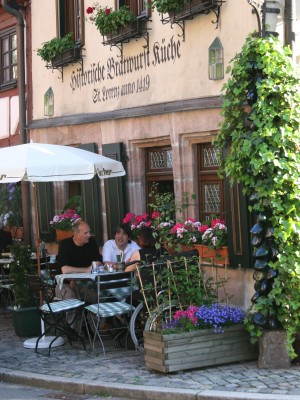
And that's our Nuremberg stopover completed. Ross likes the city and would like to return. I am much less enamoured of the place but would return for the St Sebald church and the Germanisches Nationalmuseum. But I would need some persuading and I would need to have other reasons.